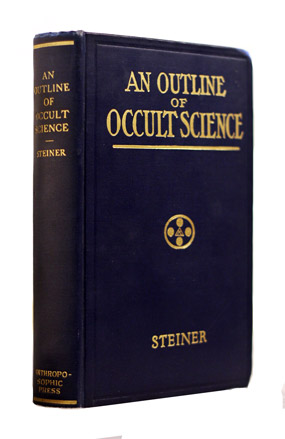Title: An Outline of Occult Science
Author: Rudolf Steiner
Publisher: The Anthroposophic Press, 1922
Condition: Hardcover, blue-purple cloth. In very good condition for its age, except for the title page being half-detached from the book. Binding is tight. Contains an inscription from 1970.
Steiner’s work argues that body, spirit, and soul are bound together and determine the capacity of cognition. Exploring and developing ideas of occult science, the world, human nature, and similarly large, difficult concepts, this work asserts the existence and importance of the ‘supersensible’ world.
About the author (from wikipedia):
Rudolf Joseph Lorenz Steiner (1861 – 1925) was an Austrian philosopher, social reformer, architect, and esotericist. Steiner gained initial recognition at the end of the nineteenth century as a literary critic and published philosophical works including The Philosophy of Freedom. At the beginning of the twentieth century, he founded a spiritual movement, anthroposophy, with roots in German idealist philosophy and theosophy; other influences include Goethean science and Rosicrucianism.
In the first, more philosophically oriented phase of this movement, Steiner attempted to find a synthesis between science and spirituality; his philosophical work of these years, which he termed spiritual science, sought to apply the clarity of thinking characteristic of Western philosophy to spiritual questions, differentiating this approach from what he considered to be vaguer approaches to mysticism. In a second phase, beginning around 1907, he began working collaboratively in a variety of artistic media, including drama, the movement arts (developing a new artistic form, eurythmy) and architecture, culminating in the building of the Goetheanum, a cultural centre to house all the arts. In the third phase of his work, beginning after World War I, Steiner worked to establish various practical endeavors, including Waldorf education, biodynamic agriculture, and anthroposophical medicine.
Steiner advocated a form of ethical individualism, to which he later brought a more explicitly spiritual approach. He based his epistemology on Johann Wolfgang Goethe’s world view, in which “Thinking … is no more and no less an organ of perception than the eye or ear. Just as the eye perceives colours and the ear sounds, so thinking perceives ideas.” A consistent thread that runs from his earliest philosophical phase through his later spiritual orientation is the goal of demonstrating that there are no essential limits to human knowledge.
Contents:
I. The Character of Occult Science
II. The Essential Nature of Mankind
III. Sleep and Death
IV. The Evolution of the Cosmos and Man
V. Cognition of Higher Worlds — Initiation.
VI. The Present and Future of Cosmic and Human Evolution
VII. Details from the Realm of Spiritual Science
1. The Ether Body of Man
2. The Astral World
3. The Life of Man After Death
4. The Course of Human Life
5. The Higher Regions of the Spiritual World
6. The Members of Man’s Being
7. The Dream State
8. The Acquirement of Supersensible Knowledge
9. Observation of Special Events and Beings of the World of Spirit




